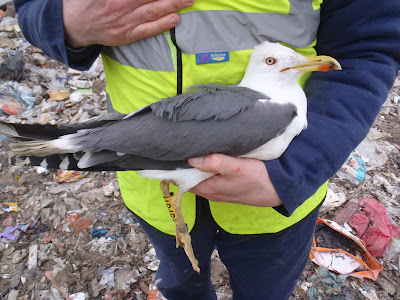The huge mound rose out of
the hole in the Earth, a mountain not of rock or soil, but of rubbish. A huge
compactor with spikes in the wheels and a massive bucket on the front beeped
and revved as it moved piles of waste around the plateau at the top of the tip.
Above hundreds upon hundreds of gulls circled, a swirling mass of grey and
white, calling and screaming, peppered with the black shadows of crows and
small flocks of starlings.
Dwarfed by the compactor and
the other trucks on the tip, a white Landrover and trailer bounced and slid its
way to a corner of the tip face and near to the sloping edge of the mound. On
opening the door a sweet, sickly smell of rotten food and rubbish assaults the
senses, but surprisingly you soon become immune only occasionally getting a
strong whiff as the morning progresses.
 |
| The gulls and the tip |
Amongst the piles of
rubbish, seven intrepid ringers set a net. Not a fine mist net strung up
between two poles, but a net lying on the ground and attached to rods which
protrude from canons. Yes canons. On firing the canons fire the rods out taking
the net with them, up and over the birds beneath.
With the net ready, we
retreat and the compactor pushes over a load of fresh rubbish, laying it in
front of the net. All there is left to do is wait, wait for the gulls to settle
and feed, wait for the right time to fire the net, wait for the right kind of
rubbish to come, and all the while trying not to think about what exactly it is
your standing on. A continual stream of trucks brings fresh rubbish to the tip
face, dumping their contents before the tractor and compactor spread it around.
The minutes tick by, it gets colder, our feet and fingers go numb. With a fresh
load spread out in front of us, finally there is interest. A moment later and a
muted boom echoes out, the net had been fired. In an instance we go from
waiting to action, scrambling up and over the piles of rubbish, towards the net
beneath which are a hundred or so gulls.
With the gulls removed from
under the net and placed into Hessian sacks, we could settle down (as settled
as one can be on a rubbish tip) to process the catch.
First off a treat - a
yellow-legged gull. Like lesser black-backed gulls and true to their name,
yellow legged gulls have well yellow legs. In adults the back is a shade
lighter than a lesser black-back and a shade darker than a herring gull. Capiche?
There are of course other more subtle differences…
 |
| Adult yellow legged gull |
Next there were 99 black-headed gulls, each one ringed with a uniquely numbered metal ring and a
bright red and white colour ring. Small and dainty, black-headed gulls are easy
to handle, and since they attain adult plumage after one breeding season they
are relatively easy to age.
Then there were 70 lesser
black-backed gulls. Bigger, meaner, with a bill that’ll draw blood if your not
careful, and even if you are! Aging in larger gulls gets more tricky as they
will go through four juvenile plumages before they reach the full adult plumage
that we all recognise. Most, if not all the birds today were adults, with only
one or two retaining the odd juvenile type feather. Again each one was ringed
with a metal and a colour ring. Recapturing gulls is unusual, so in order to
increase the sightings rate of these birds colour rings are added which can be
read in the field without having to catch the bird again.
 |
| Lesser black-backed gull |
The last bird of the day was
a beast, they are not called great black-backed gull for no good reason.
Not only are they larger overall and their back blacker, their bill is
monstrous. With this bird you can’t even give it a chance to bite, do so and it
may well snap a finger. Still never one to dodge a challenge, here I was with
this adult bird lain across my lap, head safely tucked away beneath my arm,
wrestling to put one of larger and harder rings in the BTO ringing scheme on
its leg.
 |
| Me and the beast that is the great black-backed gull |
So why, why stand in the
cold on a smelly tip in the middle of February? Why run the risk of injury
handling such big, mean birds? Landfill site may be stinky horrid places for
us, where we hide our wastefulness underground, but for gulls they are the
perfect place to feed and loaf during the winter. And they do so in vast
numbers, providing the perfect opportunity to catch them in large numbers. By
catching and colour ringing these birds we can find out where they move during
the winter, where they breed and how this may vary between different species,
ages and populations. It may surprise you but many of our large gull species
are declining, and ringing is just one tool to help establish why.
One bird in particular
during today’s catch highlighted this perfectly, a black-headed gull with a
Lithuanian ring on. Hatched last year and in all likelihood ringed as chick in
the breeding colony. Now here it was feeding on an English rubbish tip.

No comments:
Post a Comment